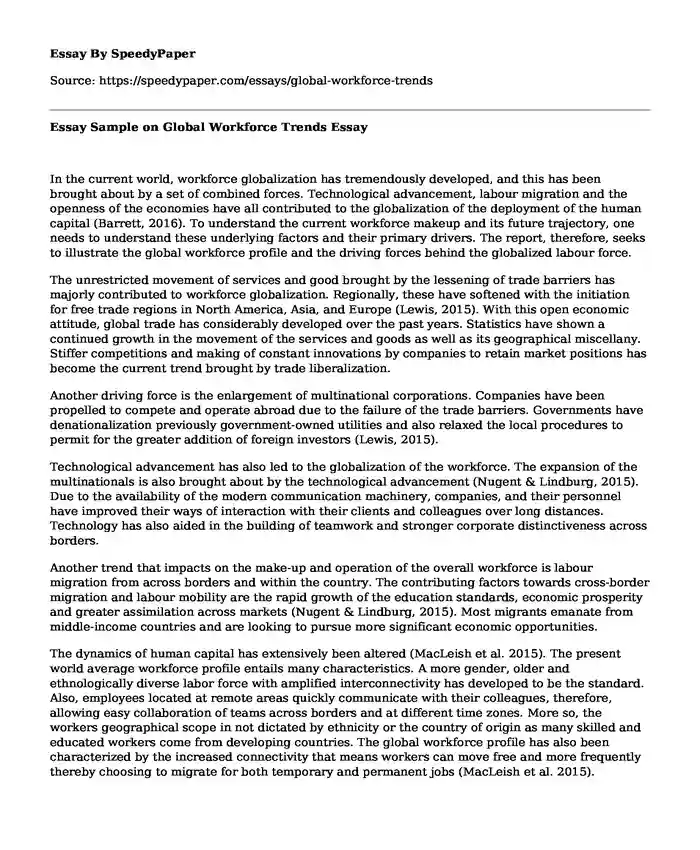
| Type of paper: | Essay |
| Categories: | Human resources Job |
| Pages: | 3 |
| Wordcount: | 703 words |
In the current world, workforce globalization has tremendously developed, and this has been brought about by a set of combined forces. Technological advancement, labour migration and the openness of the economies have all contributed to the globalization of the deployment of the human capital (Barrett, 2016). To understand the current workforce makeup and its future trajectory, one needs to understand these underlying factors and their primary drivers. The report, therefore, seeks to illustrate the global workforce profile and the driving forces behind the globalized labour force.
The unrestricted movement of services and good brought by the lessening of trade barriers has majorly contributed to workforce globalization. Regionally, these have softened with the initiation for free trade regions in North America, Asia, and Europe (Lewis, 2015). With this open economic attitude, global trade has considerably developed over the past years. Statistics have shown a continued growth in the movement of the services and goods as well as its geographical miscellany. Stiffer competitions and making of constant innovations by companies to retain market positions has become the current trend brought by trade liberalization.
Another driving force is the enlargement of multinational corporations. Companies have been propelled to compete and operate abroad due to the failure of the trade barriers. Governments have denationalization previously government-owned utilities and also relaxed the local procedures to permit for the greater addition of foreign investors (Lewis, 2015).
Technological advancement has also led to the globalization of the workforce. The expansion of the multinationals is also brought about by the technological advancement (Nugent & Lindburg, 2015). Due to the availability of the modern communication machinery, companies, and their personnel have improved their ways of interaction with their clients and colleagues over long distances. Technology has also aided in the building of teamwork and stronger corporate distinctiveness across borders.
Another trend that impacts on the make-up and operation of the overall workforce is labour migration from across borders and within the country. The contributing factors towards cross-border migration and labour mobility are the rapid growth of the education standards, economic prosperity and greater assimilation across markets (Nugent & Lindburg, 2015). Most migrants emanate from middle-income countries and are looking to pursue more significant economic opportunities.
The dynamics of human capital has extensively been altered (MacLeish et al. 2015). The present world average workforce profile entails many characteristics. A more gender, older and ethnologically diverse labor force with amplified interconnectivity has developed to be the standard. Also, employees located at remote areas quickly communicate with their colleagues, therefore, allowing easy collaboration of teams across borders and at different time zones. More so, the workers geographical scope in not dictated by ethnicity or the country of origin as many skilled and educated workers come from developing countries. The global workforce profile has also been characterized by the increased connectivity that means workers can move free and more frequently thereby choosing to migrate for both temporary and permanent jobs (MacLeish et al. 2015).
All these changes produce positive impacts for workers and firms but also there are the negative consequences that come with them (Capello & Caragliu & Fratesi, 2015). The shortage of experienced leaders, inconsistency in the educational standards and lack of cultural knowledge all imply the new challenges encountered in the new workforce era. Thus, understanding the ways in which the modern workforce profile has progressed and will continue to transform is critical to companies in general if they can manage to lessen its downsides and exploit its potential.
References
Barrett, S. (2016). How to address local healthcare needs across a global workforce. Employee Benefits Online.
Capello, R., Caragliu, A., & Fratesi, U. (2015). Global trends and the economic crisis: Future alternative European growth strategies. Technological Forecasting & Social Change, 98120-136.
Lewis, L. C. (2015). Nursing Workforce Trends Demand Transformational Leadership. The Journal Of Nursing Administration, 45(10 Suppl), S1-S2.
MacLeish, M. M., Akinyede, J. O., White, R. J., Goswami, N., & Thomson, W. A. (2015). Global space workforce development: a model for partnership building and knowledge transfer to developing space-faring societies. Acta Astronautica, 116106-116.
Nugent, K. L., & Lindburg, L. (2015). Life sciences workforce trends evolve with the industry: as the biotech industry grows and shifts within an increasingly global economy, so does its need for talent that spans discovery through commercialization. Nature Biotechnology, (1), 107.
Cite this page
Essay Sample on Global Workforce Trends. (2019, Sep 16). Retrieved from https://speedypaper.net/essays/global-workforce-trends
Request Removal
If you are the original author of this essay and no longer wish to have it published on the SpeedyPaper website, please click below to request its removal:
- Marketing Essay Sample on Product Promotion
- Dow Strategies in Business, Free Essay
- Free Essay about the United Nations Human Rights Council
- Big Mama - Movie Review Essay Example
- Roles and Responsibilities in Leadership and Management - Free Essay for You
- Essay Example on Throwing Elephant: A Guide to Managing Up and Business Life
- Free Essay on Terrorism and Homeland Security: Future Prospects
Popular categories




